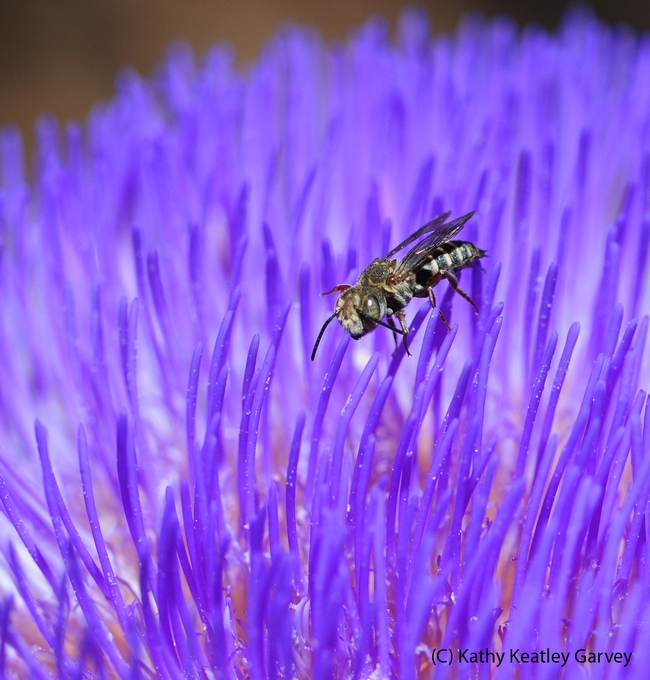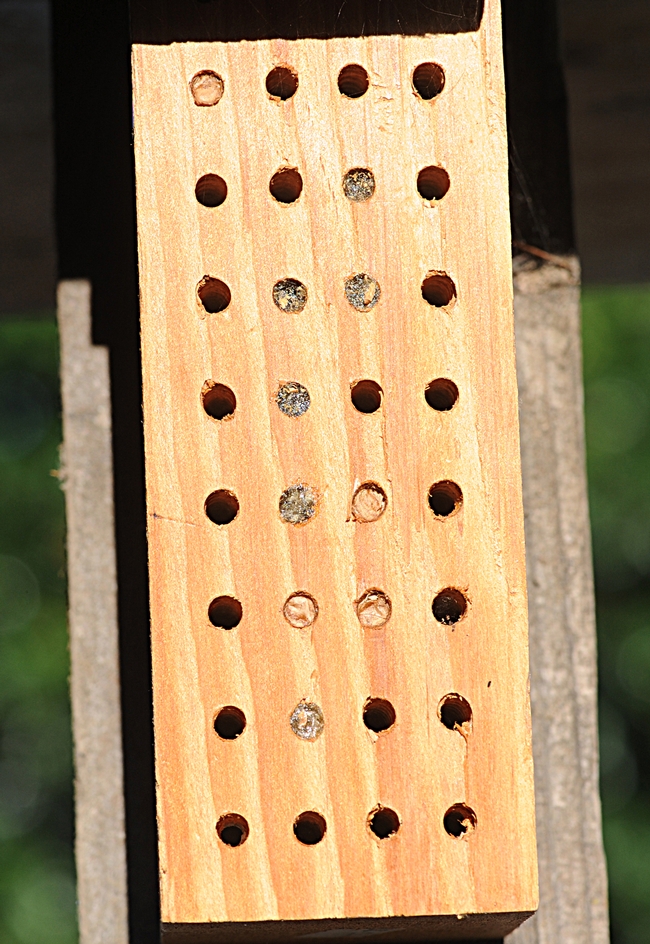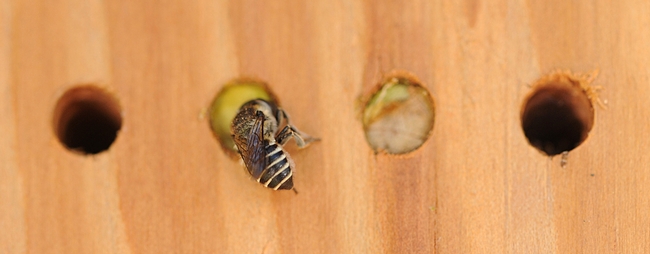- Author: Kathy Keatley Garvey
If you want to attract insects to your garden, plant an artichoke and let it flower.
You'll get honey bees, syrphid flies, butterflies, carpenter bees and leafcutter bees. (And well, a few predators, such as spiders and wasps.)
Today we saw leafcutter bees (Megachile spp.) tumbling in the purple strands, looking so much like residents of a gated community. A purple gated community.
These native bees, so named because they cut fragments from leaves and bring them back to line their nests, are excellent pollinators. They nest in our bee condo, just inches away from the artichoke plants.
Then we saw a male cuckoo leafcutting bee (below), genus Coelioxys, as identified by native pollinator specialist Robbin Thorp, emeritus professor of entomology at UC Davis. "The females hide their eggs between the leaves in Megachile nests and their larvae kill the host egg or larva and complete their development on the pollen provided by the host female," he said.
With Megachile, if you provide a bee condo (a wood block drilled with holes), you may see these tiny insects provisioning their nests. (See the list of resources provided by Thorp, on the Harry H. Laidlaw Jr. Honey Bee Research Facility website.
All in all, leafcutter bees are a star attraction for National Pollinator Week, which began Monday, June 18 and continues through Sunday, June 24.


- Author: Kathy Keatley Garvey
All winter long my bee condo housed 16 tenants...and one earwig.
And quite comfortably, too, thank you.
It all began last fall when the leafcutting bees laid their eggs, provisioned each nest with a nectar/pollen ball, and plugged it with leaves.
Just about every morning, I did a bed check. Yes, 16 tenants and one earwig. (In actuality, there were probably more of those nasty little earwigs, but each time I checked, I found only one. But lots of frass!)
Bee condos are really just wood blocks drilled with tiny holes for native bee nests.
In late April and early May, the tenants began to stir. As of yesterday, 13 holes had popped open. Ah, emergence! The nocturnal earwig? Nowhere in sight.
You, too, can rear leafcutting bees (Megachile spp.) in your yard. All you need is the housing, which you can buy at most beekeeping supply stores or online. You can also go online and buy the plans to build them.
Senior conservation associate Matthew Shepherd of The Xerces Society for Invertebrate Conservation, in his fact sheet about native bee nesting sites, wrote: "There are 4,000 species of native bees in North America. Together they form the most important group of pollinators. Like all wildlife they are affected by changes in our landscapes, especially the loss of nesting sites. Bees make nests in which they create and provision brood cells for their offspring. In many modern landscapes, a desire for neatness has usually resulted in the removal of bare ground, dead trees, and untidy corners of rough grass—all important nesting sites for bees."
Native pollinator specialist Robbin Thorp, emeritus professor of entomology at the University of California, Davis, has provided a list of resources for native bee nesting requirements. It's available free on the Harry H. Laidlaw Jr. Honey Bee Research Facility website.
And, the Xerces Society recently published a Pollinator Conservation Handbook where you can find more information about our pollinators.
Just don't expect all your tenants to be pollinators, and all your pollinators to be tenants.


- Author: Kathy Keatley Garvey
When you try to attract leafcutting bees (Megachile spp.) to your bee condos, you may also attract something else.
Wasps.
Bee condos (wood blocks drilled with holes for native bee nests) are a favorite of gardeners and bee enthusiasts. Leafcutting bees lay their eggs in them, provision them with food for the winter, and seal the holes with leaves. Then, in the spring, if all goes well, their offspring will emerge.
Well, some of them will.
Native pollinator specialist Robbin Thorp, emeritus professor of entomology at UC Davis, last year installed some bee condos in the Häagen-Dazs Honey Bee Haven, a half-acre bee friendly garden located next to the Harry H. Laidlaw Jr. Honey Bee Research Facility on Bee Biology Road.
Unlike most bee condos, though, his are removable. That is, you can take them apart and look inside.
Thorp recently did just that. On Dec. 22, he opened one of them and voila! Immature leafcutting bees sharing their bed with immature wasps. The predators and their prey. Strange bedfellows, indeed.
What species of wasp?
"The wasp is one of the solitary mason wasps (family Eumenidae) that uses caterpillars as food for their young," Thorp said. "It may be a species in genus Euodynerus. But I will need to wait until they develop to adults to be sure which genus and species it is."
If you want to attract leafcutting bees, check out Thorp's list of resources for native bee nests.
Just don't expect to rear only native bees.



- Author: Kathy Keatley Garvey
When you install bee condos--those wooden blocks with holes drilled in them to attract nesting native bees--sometimes you get the unexpected.
Like earwigs!
Home invasion! Home invasion!
We installed two bee condos, each about the size of a brick, in our yard. One is for leafcutting bees (genus Megachile) and is filled quite nicely, thank you, with 10 tenants. Another, with larger holes, is for blue orchard bees (BOBs, genus Osmia). Despite our "vacancy" sign (discounted rates, free WiFi, free continental breakfasts), nothing is occupying it except earwigs.
Earwigs! We're wigged out.
They were especially persistent in the damp weather.
Native bee guru Robbin Thorp, a native pollinator specialist and emeritus professor of entomology at the University of California, Davis, who has researched native bee holes with colleagues John Barthell and Gordon Frankie, told us: "We found that mostly wasps and earwigs occupied the largest holes. Only a few of the introduced leafcutting bees that could not find appropriate size holes when bee populations were abnormally high would make aberrant nests in the larger cavities. By 1990, we scaled back to the three diameters that our bees use: 4.5, 6.5 and 8 mm (3/16, 1/4, and 5/16 inch) for our studies in California."
The earwigs, Thorp says, "are not so likely to be present now that the weather is hot and dry, but in shady, damp, cool areas, and especially early in the year when it is wet and cool, they can be a problem."
Their research, published in Environmental Entomology in 1998 and titled “Invader Effects in a Community of Cavity Nesting Megachilid Bees (Hymenoptera: Megachilidae)” involved native bee species and their introduced competitors.
Like earwigs.
In their paper, they wrote that the European earwig (Forficttla auricularia L) from Eurasia and northern Africa, was introduced into North America at the turn of the century. "It has invaded most counties in the state of California since its apparent introduction in the late 1910s (Essig 1923, Langston and Powel! 1975)," they wrote. "Its populations have grown to high numbers in natural areas, especially in riparian zones where humidity levels are relatively high (Barthel! and Stone 1995). The earwig is most active during evening hours, climbing into tree crowns to scavenge and hunt but hiding in cracks, crevices, or holes during the daylight hours."
Active indeed. Those European earwigs soon found our condo for BOBs (which perhaps should now mean Big ol' Blast).





